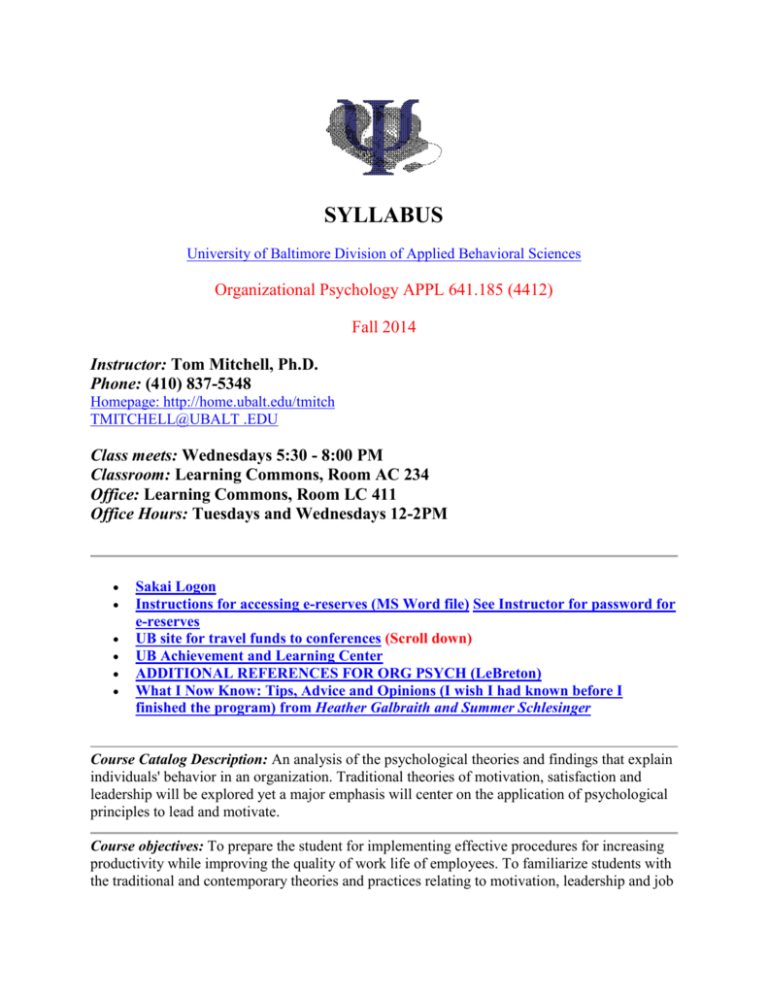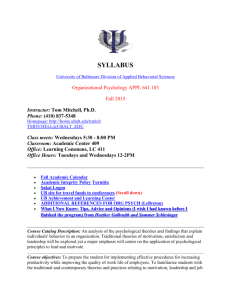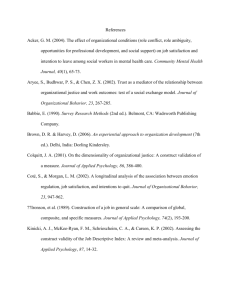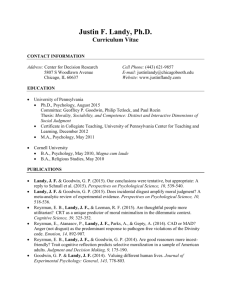SYLLABUS University of Baltimore Division of Applied Behavioral
advertisement

SYLLABUS University of Baltimore Division of Applied Behavioral Sciences Organizational Psychology APPL 641.185 (4412) Fall 2014 Instructor: Tom Mitchell, Ph.D. Phone: (410) 837-5348 Homepage: http://home.ubalt.edu/tmitch TMITCHELL@UBALT .EDU Class meets: Wednesdays 5:30 - 8:00 PM Classroom: Learning Commons, Room AC 234 Office: Learning Commons, Room LC 411 Office Hours: Tuesdays and Wednesdays 12-2PM Sakai Logon Instructions for accessing e-reserves (MS Word file) See Instructor for password for e-reserves UB site for travel funds to conferences (Scroll down) UB Achievement and Learning Center ADDITIONAL REFERENCES FOR ORG PSYCH (LeBreton) What I Now Know: Tips, Advice and Opinions (I wish I had known before I finished the program) from Heather Galbraith and Summer Schlesinger Course Catalog Description: An analysis of the psychological theories and findings that explain individuals' behavior in an organization. Traditional theories of motivation, satisfaction and leadership will be explored yet a major emphasis will center on the application of psychological principles to lead and motivate. Course objectives: To prepare the student for implementing effective procedures for increasing productivity while improving the quality of work life of employees. To familiarize students with the traditional and contemporary theories and practices relating to motivation, leadership and job satisfaction. To enable the student to apply the theories to improving organizational effectiveness. Texts required: Landy, Frank J., & Conte, Jeffrey M. (2013). Work in the 21st Century: An Introduction to Industrial and Organizational Psychology. 4th edition Blackwell Publishing ISBN- 978-1-1182920-7 Deci, Edward, & Flaste, Richard (1995) Why We Do What we Do (1995) Penguin Press ISBN: 0 14 02.5526 5 Other assigned readings: (see schedule below) Web Sources: Work in the 21st Century: An Introduction to Industrial and Organizational Psychology. 4th edition Landy & Conte Text materials online All cases (Motivation/Satisfaction/Leadership) for this class http://www.siop.org Society for Industrial/Organizational Psychology (see IO related sites) Psychology journals on line SIOP Exchange http://siopexchange.typepad.com/the_siop_exchange/ Society for Human Resources Management http://www.shrm.org Chesapeake Human Resources Association http://www.chra.com Personnel Testing Council of Washington D.C. http://www.ptcmw.org/ Description of I & O psychology http://en.wikipedia.org/wiki/Industrial_and_organizational_psychology Journal of Applied Psychology Class format: Lecture, class discussions and group problem solving activities. Course requirements: 1. Demonstration of an understanding of assigned readings; 2. Successful completion of two exams 3. Three individual case reports (submitted on due date) 4. Responses to Chapter questions posted in discussion forums (Sakai). Cases for class reports INSTRUCTIONS FOR PREPARATION OF CASE REPORTS Good example of Case Report: Benefits for Acme Aluminum How to write an executive summary Effect v. Affect...know the difference Grade determination: Exams (40%) + Cases (60%) = 100% Mid term and final exams (20% each) + three case reports (20% each) Cases available: ALL CASES ON LINE Range of letter grades for each report: A, B+, B, C+, C, F Schedule of Assignments: Week 1: August 27 Landy & Conte: Chapter 1: What is Industrial & Organizational Psychology? (modules 1.1 -1.4) Chapter 1 Questions Description of course objectives, requirements, Cases for individual & team problem solving assignments Trial case: The Skeptical Ceo Example of a good paper for this trial case: Applications of Industrial and Organizational Psychology: Benefits for Acme Aluminum The Future of HR NOT SO FAST (on F. Taylor Jill Lepore, 2009) Week 2: September 3 Landy & Conte: Chapter 2: Methods and Statistics in Psychology (modules 2.1 - 2.4) Chapter 2 Questions Difference between I/O and HR Practitioner (TIP, July, 2000 by Lori Foster) Scales of Measurement PPT Week 3: September 10 Landy & Conte: Chapter 8 The Motivation to Work (Modules 8.1 & 8.2) Chapter 8 Questions Automaton the Ghost in the Machine Tolman and Honzik latent learning Equity theory (PPT) U. Toronto Motivation theory (Instructor: Chun Wei Choo) Porter Lawler VIE model (bola.biz) Manfacturing to target Six sigma Job Char Model (JCM) power point (JCM) Hackman & Oldham: (Landy text: p352) Job Diagnostic Survey (JDS) SUMMARY OF JDS (Datner's) Choose a Case (any one) Cases on Motivation *** Report due for trial case The Skeptical CEO (optional)****** Week 4: September 17 Landy & Conte: Chapter 8 The Motivation to Work (con't) (Modules 8.3 & 8.4) Chapter 8 questions Judge et al. (2002). Relationship of personality to performance: Motivation: A metaanalytic review. Journal of Applied Psychology, 87, 797-807. Deci & Flaste: Why We Do What We Do Ryan, R. & Deci, E. (2000) Self-determination theory and the facilitation of intrinsic motivation, social development, and well-being. American Psychologist., 55, 68-78. Articles: Kohn, A. (1993) Why incentive plans cannot work. Harvard Business Review. Sept-Oct. Stewart, G.B. et al. (1993) Rethinking Rewards Harvard Business Review. Nov-Dec. Kohn Responds The Secret of Effective Motivation NYT 7-4-14 Incentive pay for Gov't disability wkrs (Washington Post 8-26-13) Sources for Deci and Ryan Measures: Deci and Ryan's Self Determination Theory Individual Styles Questionnaire General Causality Scale Description (Deci & Ryan) GCOScores for two Org Psych Classes Individual Styles (GCOS) scoring temlate (Excel) Week 5: September 24 Landy & Conte: Chapter 9 Attitudes, Emotions, and Work (Module 9.1) Chapter 9 Questions Saari, L. M., & Judge, T. A. (2004) Employee attitudes and job satisfaction. Human Resource Management, Vol. 43, No. 4, Pp. 395–407 SIOP Job Attitudes Group discussion questions Complete the JSS for a job you have had, score it and bring the completed form to class. (use the MS Word version, not the online one) Description of several Job Satisfaction Scales Smith Kendall Job Satisfaction (JDI) Paul Spector's Job Satisfaction Scale Info JSS on line Job-related Affective Well-being Scale, JAWS JSS APPL 641 class norms Choose a case (any one) Cases on Job Satisfaction Week 6: October 1 Landy & Conte: Chapter 9 Attitudes, Emotions, and Work (con't) (Modules 9.2 & 9.3) Chapter 9 Questions Article: Bakker, A. B. (2011) An evidence-based model of work engagement. Current Directions in Psychological Science, 20, 265-269. DOI: 10.1177/0963721411414534 JSS Fa 13 student sample cf to Norms (Siddiq Kassam) Demonstration of Employee Satisfaction survey report: Tyrone Org Survey Example of PPT presentation to management: Tyrone Org Results *** Report due for Case: Motivation *** Week 7: October 8 Review for midterm Special guest appearance from Prometric Jessica Russell, Corporate Recruiter and Kate Hill, Sr. Manager of Test Development Week 8: October 15 *** Midterm Exam *** Week 9: October 22 Landy & Conte: Chapter 11 Fairness and Diversity in the Workplace (all Modules) Chapter 11 Questions WSJ article: Get rid of the Performance Review hand out GZTS to be completed and returned by Nov 2 *** Week 10: October 29 Landy & Conte: Chapter 12 Leadership (Modules 12.1 & 12.2) Chapter 12 Questions LMX Exchange theory (SIOP) Vroom Yetton Decision Tree Barrick, M. R., & Mount, M.K. (1991) The Big Five personality dimensions and job performance. Personnel Psychology. 44, 1-26 Mount, Barrick & Strauss (1994) Validity of observer ratings of the big five personality factors J. of Applied Psych. v.79, no. 2. pp 272-279 Big five personality characteristics (Handout individual difference measures) *** Report due for Case: Satisfaction *** Choose a Case (any one) Cases on Leadership Week 11: November 5 Landy & Conte: Chapter 12 Leadership (con't) (Modules 12.3 & 12.4) Chapter 12 Questions Review midterm exam answers ***collect GZTS inventories **** Humanitarian Work Psychology ppoint Global Work Force Brochure PDF file Gender in Leadership (SIOP) Article: Bass, B. M. (1997) Does the transactional-transformational Leadership paradigm transcend organizational and national boundaries? American Psychologist, 52, 130-139. List of 19 Leadership SKAs Startling evidence that working causes productivity Week 12: November 12 Personality Assessment Inventories Special Guest: Mark Tregar, MS, Managing Consultant, IBM GZTS descriptives for Fa 3013 Real World Consulting Guilford-Zimmerman Temperament Survey Guilford-Zimmerman Temperament Survey stats Guilford-Zimmerman Temperament Survey stats for Gender (3 scales) California Psychological Inventory Scale Definitions NEO-PI Big Five IPIP 16PF Week 13: November 19 Landy & Conte: Chapter 13 Teams in Organizations (Modules 13.1 & 13.3) Chapter 13 Questions *** Report due for Case: Leadership *** Peter Drucker' Legacy: (WSJ) article 11-14-05 Atlas Box company Flight 90 Study of Boredom in Committee meetings Team decision process (power point slides) Some ideas are so bad that only team efforts can account for them WSJ 9-29-04 Team Performance (Small Groups Research: Sage) November 26 **** Thanksgiving Holiday ***** Week 14: December 3 review for final exam Separation Anxiety: Canon stays in Japan WSJ 9/27/04 WSJ Peer group pressure Homeland Security Merger (Balt Sun 11/26/02) What problems of culture change will the homeland security merger experience? Week 15: December 10 ***Final Exam *** Readings on reserve in Langsdale Library: e-Reserve holdings Barrick, M. R., & Mount, M.K. (1991) The Big Five personality dimensions and job performance. Personnel Psychology. 44, 1-26 Bass, B. M. (1997) Does the transactional-transformational Leadership paradigm transcend organizational and national boundaries? American Psychologist, 52, 130-139. Collins, J. M. (1998). Race, Job Applicants, and the Five-Factor Model of Personality: Implications for Black Psychology, Industrial/Organizational Psychology, and the Five-Factor Theory. Journal of Applied Psychology Deci, R. & Ryan, R. (2000) Self-determination theory and the facilitation of intrinsic motivation, social development, and well-being. American Psychologist., 55, 68-78. Kohn, A. (1993) Why incentive plans cannot work. Harvard Business Review. Sept-Oct. (reserve) Mount, Barrick & Strauss (1994) Validity of observer ratings of the big five personality factors J. of Applied Psych. V.79, no. 2. pp 272-279 Stewart, G.B. et al. (1993) Rethinking Rewards. Harvard Business Review. Nov-Dec. (Reserve) back to TMitch homepage BACK TO TOP




